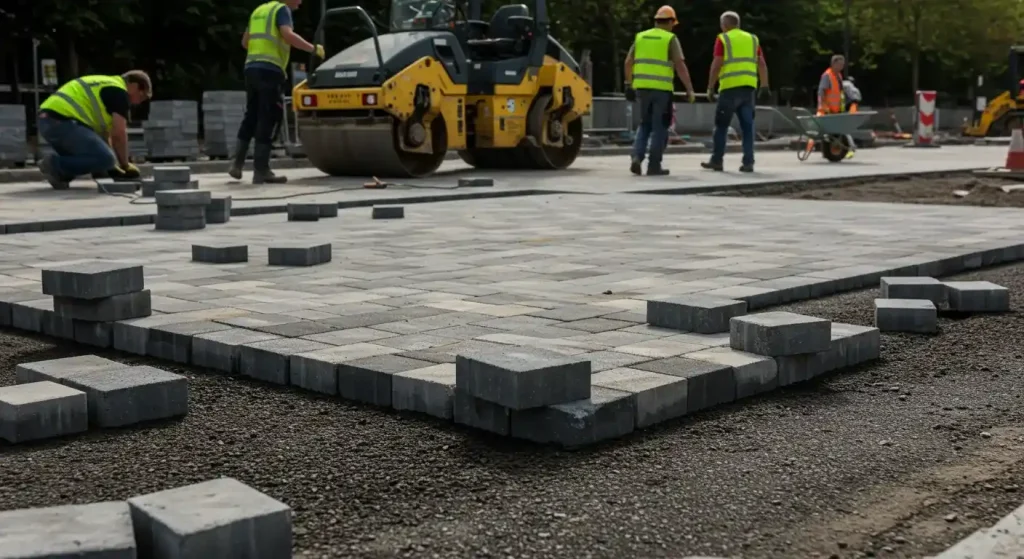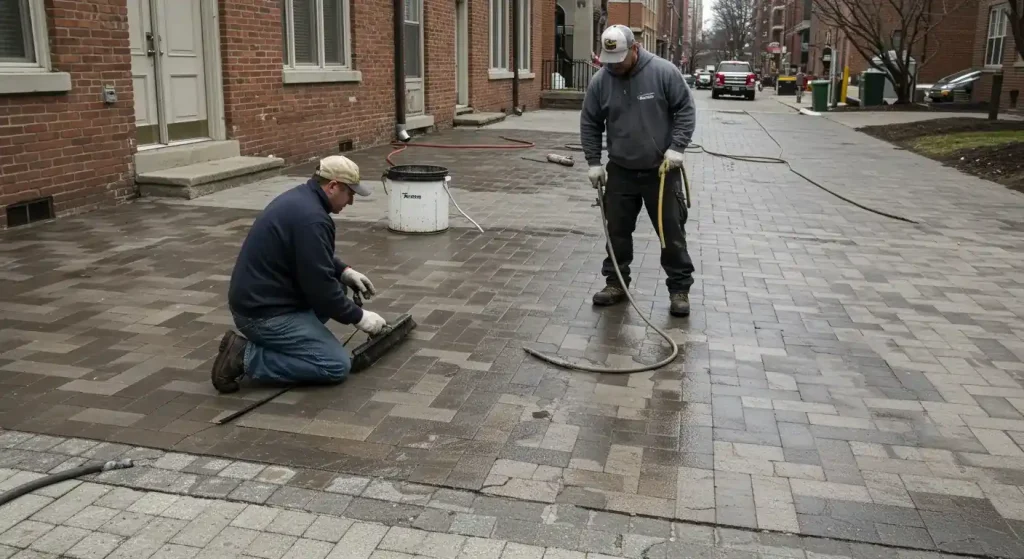If you’re planning to upgrade your outdoor space—whether it’s a driveway, patio, or walkway—you’ll likely come across a common decision: pavers or concrete? Both are strong materials that can handle traffic and weather. But your choice can impact how your landscape performs over time, especially in a climate like New York’s.
This blog post explains the differences, strengths, and weaknesses of both pavers and concrete so you can make the right call for your home or commercial property.
Understanding the Basics
Before you compare pros and cons, it’s important to understand what each material really is and how it works.
What Is Concrete?
Concrete is a monolithic surface created by pouring a mixture of cement, sand, water, and aggregates into a form. Once poured, the material cures and hardens into a flat, continuous slab. It can be finished in different textures like broom-finished, stamped, or polished.
What Are Pavers?
Pavers are individual pieces made from concrete, clay brick, porcelain, or natural stone. They’re set over a compacted gravel base and sand bedding. Each paver interlocks with the others, creating a flexible surface that can shift slightly with the ground without breaking.
In simple terms, concrete is one large piece. Pavers are a puzzle of smaller units.

Pros of Using Pavers
1. High Durability and Strength
Pavers are incredibly tough. In most cases, they’re stronger than poured concrete. Because they are manufactured in molds under high pressure, they can withstand heavy loads without cracking. This makes them a good choice for driveways, especially in high-traffic areas.
Unlike concrete slabs, pavers don’t rely on one single mass. Even if some shifting happens beneath the surface, the individual units stay intact and functional.
2. Flexibility During Freeze-Thaw Cycles
New York’s winters are harsh. The ground expands and contracts as temperatures change. Concrete struggles in these conditions because it’s rigid. As the ground moves, the slab can crack.
Pavers are different. Since they’re not glued together, they allow minor ground movements without damage. They shift individually with the freeze-thaw cycle. That flexibility gives pavers a clear edge in areas with extreme seasonal weather.
3. Simple, Cost-Effective Repairs
If a section of your paver patio or driveway gets stained with oil, salt, or rust, you don’t need to redo the entire surface. You can lift and replace the damaged pavers. It’s a low-cost fix that doesn’t affect the rest of your landscape.
With poured concrete, repairs often involve cutting out large chunks and re-pouring—an expensive and labor-heavy job.
4. Design and Customization Options
Pavers come in many colors, textures, and patterns. You can go for a modern grid layout or an old-world cobblestone look. You can mix colors, add borders, or create geometric patterns.
Whether you’re building around a pool or installing a front entrance, pavers give you the creative freedom to match your style and architecture. Concrete, on the other hand, requires stamping or staining to reach the same level of customization.
5. Better Water Drainage
Paver systems are more permeable than concrete slabs. Water flows through the joints between each paver and drains into the base layer below. This prevents pooling and reduces the chance of water damage or erosion.
In New York’s rainy and snowy seasons, this extra drainage feature can reduce surface ice and slip hazards during winter.
Cons of Using Pavers
1. Higher Initial Installation Cost
Pavers can be expensive to install. Both the material cost and labor are higher compared to concrete. The process requires grading the site, laying a gravel base, compacting layers, and placing each paver by hand.
Although the long-term maintenance is easier and often cheaper, the upfront investment can be a challenge if you’re working with a limited budget.
2. More Time to Install
Installing pavers takes more time than pouring a concrete slab. The installer has to lay each unit manually and ensure proper spacing, alignment, and leveling. Depending on the size of your project, this can add several days to the timeline.
If you’re trying to finish a project quickly—maybe for an event or sale—this slower pace may not work in your favor.
3. Potential for Weed Growth and Shifting
Without proper joint sand and edge restraints, weeds can grow between the pavers. Over time, foot traffic or moisture can cause some pavers to shift or settle unevenly. Regular maintenance like sweeping in polymeric sand and resealing may be needed every few years to keep the joints tight and weed-free.
Pros of Using Concrete
1. Lower Upfront Cost
Concrete is usually cheaper than pavers for the same size area. If you need a cost-effective solution for a large patio, driveway, or walkway, concrete can keep your project within budget.
Materials are relatively inexpensive, and labor is faster, which helps reduce total installation costs.
2. Fast and Efficient Installation
Pouring concrete is quicker than laying individual pavers. Once the forms are in place, the concrete can be poured and leveled in a single day. After curing for a few days, the surface is ready to use.
If time is a priority for your project, concrete gives you a fast turnaround with less labor involved.
3. Clean, Smooth Appearance
Concrete offers a sleek, continuous surface with fewer joints. If you want a minimalistic look or modern finish, concrete is a solid choice. It can also be stamped or stained to mimic the look of pavers or natural stone, though this adds to the cost.
4. Low Maintenance (Initially)
When sealed properly, concrete is resistant to stains and easy to clean. It doesn’t require much attention in the first few years. Occasional sweeping and washing with a hose will keep it looking fresh.

Cons of Using Concrete
1. Cracking Over Time
Concrete has one major drawback: it cracks. That’s nearly unavoidable in a climate like New York. As the ground shifts with temperature changes, the rigid slab develops stress fractures.
Even with control joints (cut lines designed to guide where the cracks occur), the slab will likely show visible damage over time. These cracks can widen or shift, creating tripping hazards and lowering the property’s curb appeal.
2. Difficult and Costly Repairs
Concrete repairs are rarely seamless. Once it cracks, you can patch it, but the area won’t match the original surface. In many cases, homeowners need to remove and re-pour the slab, which can be expensive.
Unlike pavers, you can’t just replace one section without disturbing the rest.
3. Limited Style Flexibility
While stamped concrete has improved in recent years, it still doesn’t match the design depth of actual pavers. If your goal is a textured, patterned, or colorful finish, you’ll need to invest in extra materials and labor.
This can drive the price close to or even above that of pavers—without offering the same flexibility or repair options.
4. Poor Water Drainage
Concrete is non-permeable, so water can pool on the surface if the area isn’t sloped correctly. This leads to puddles, ice patches in winter, and faster wear along the edges. Without proper grading and drainage solutions, water can even seep underneath and cause erosion or frost heaving.
New York Climate Considerations
New York weather swings from hot summers to freezing winters. That puts a lot of pressure on your outdoor surfaces. Concrete often struggles here because it can’t flex or shift. Cracks from frost or salt damage are common.
Pavers handle this better. The individual units move slightly with the freeze-thaw cycle and prevent large cracks from forming. For that reason alone, pavers are usually the better choice for long-term durability in this region.
Further Readings
- Top 5 Trends in Paver Landscaping for New York in 2025
- The Eco-Friendly Choice: Permeable Pavers for Sustainable Landscaping
- Top 10 Benefits of Choosing Concrete Pavers for Your Driveway
Conclusion
If you’re building a driveway, patio, or walkway in New York, both pavers and concrete offer value. The best choice depends on your budget, design preference, and how long you plan to stay in your home.
Choose pavers if you want long-term durability, style options, and fewer repair headaches over time. They cost more upfront but hold up better in New York’s climate.
Choose concrete if you need a fast, cost-effective option and you’re okay with some maintenance or eventual repairs. It’s practical but comes with limitations in design and long-term performance.
Whichever material you choose, make sure you hire a qualified contractor who understands the soil, slope, and weather conditions in your area. That’s the real key to a landscape that lasts.
